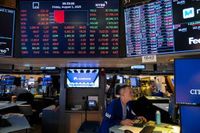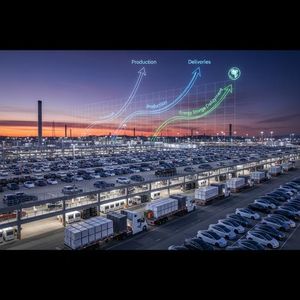On August 27, 2025, the world’s financial markets found themselves in a holding pattern, with traders and investors everywhere holding their breath for one big reason: Nvidia’s quarterly earnings report. The anticipation was palpable, not just because Nvidia is a tech juggernaut, but because its results were widely expected to offer a crucial glimpse into the state of artificial intelligence (AI) and whether the recent market exuberance was justified—or just another bubble in the making. According to the Associated Press, Nvidia’s financial results were scheduled to be released after trading ended in New York, and the entire market seemed to be bracing for what could be a pivotal moment.
Across major stock exchanges, shares were mixed. In Europe, Germany’s DAX edged down 0.2% to 24,117.06, while the CAC 40 in Paris rose 0.4% to 7,741.15. Britain’s FTSE 100 barely budged, closing at 9,269.36. Futures for the S&P 500 and Dow Jones Industrial Average were essentially flat, reflecting the cautious mood. Asian markets, meanwhile, told their own story: Hong Kong’s Hang Seng index fell 1.3% to 25,201.76, and the Shanghai Composite dropped 1.8% to 3,800.35. According to AP reporting, the Shanghai benchmark had been hitting record highs recently, so some investors were likely cashing out to lock in gains.
Japan’s Nikkei 225 managed a 0.3% gain to reach 42,520.27, and South Korea’s Kospi also advanced 0.3% to 3,187.16. Australia’s S&P/ASX 200 ticked up 0.3% to 8,960.50, while Taiwan’s Taiex climbed 0.9%. Taiwan Semiconductor Manufacturing Co.—the world’s largest contract chip maker—gained 1.4% after a senior official downplayed concerns about the impact of potential new U.S. tariffs on chip exports. In contrast, markets in India were closed for a public holiday, coinciding with the implementation of steep 50% tariffs on exports to the United States—a move expected to hit labor-intensive sectors like textiles particularly hard.
Currency markets were just as turbulent. Asian currencies, including the Japanese yen and South Korean won, declined as the U.S. dollar strengthened, according to reporting by AInvest. On August 27, the dollar rose to 148.06 yen from 147.43 yen, while the euro slipped to $1.1586 from $1.1643. This shift put additional pressure on Asian economies, just as investors prepared for Nvidia’s earnings report, which was scheduled for later in the week.
So why all the fuss about Nvidia? The company is more than just a tech darling—it’s a global leader in programmable graphics processors and the software that powers them. According to MarketScreener, Nvidia’s net sales are primarily driven by computing and networking solutions, which account for a staggering 77.8% of its total sales. These products serve a range of sectors: data storage (78%), gaming (17.1%), professional visualization (2.5%), automotive (1.8%), and a smattering of other industries (0.6%). Geographically, Nvidia’s sales are spread across the United States (44.3%), Taiwan (22%), China (16.9%), and other regions (16.8%).
The company has not been resting on its laurels. Its latest innovation, the DRIVE AGX Thor developer kit, is designed to speed up the design and deployment of autonomous vehicles and intelligent mobility solutions. Built on the Blackwell architecture and powered by the DriveOS 7 software stack, the kit is said to meet rigorous safety and cybersecurity standards. Nvidia’s strategic collaboration with RealSense, Inc. further cements its leadership in robotics. By integrating RealSense’s advanced D555 depth-sensing cameras with Nvidia’s robotics platforms, the partnership aims to create scalable, AI-defined solutions for industries ranging from manufacturing and logistics to healthcare.
All of this innovation is happening against a backdrop of significant market volatility and a global economy in flux. On the day of Nvidia’s anticipated earnings, the company’s stock was trading at $182.56, up $0.79 or 0.43%, according to Barchart.com. Major U.S. indices also showed small gains: the S&P 500 closed 0.4% higher, the Dow industrials gained 0.3%, and the Nasdaq added 0.4%. Yet, as AP noted, the mood was subdued, with everyone waiting for Nvidia’s numbers to drop.
Economic data out of China added to the uncertainty. The Chinese government reported that industrial profits fell 1.7% from January to July compared to the previous year. That’s actually an improvement from the 2.8% drop seen in the first half of 2025, but July’s profits still fell 1.5% year-on-year. These figures, while slightly better, underscore the challenges facing the world’s second-largest economy.
Meanwhile, in the U.S., consumer confidence took a modest dip in August, marking the eighth straight month of growing anxiety over a weakening job market. The Conference Board’s monthly survey showed a small decline, in line with economists’ expectations. Despite this, Wall Street had notched big gains the previous week, buoyed by hopes that the Federal Reserve would soon cut interest rates. Traders are now betting—with an 87% probability, according to CME Group data—that the Fed will trim its benchmark rate by a quarter of a percentage point at its next meeting in September.
But the U.S. political landscape is adding another layer of unpredictability. President Donald Trump has escalated his feud with the Federal Reserve, announcing the firing of Governor Lisa Cook. Cook’s lawyer has said she’ll sue the administration to try to stop the firing. Trump has also threatened to fire Fed Chair Jerome Powell, though he is only one of twelve votes that decide interest rate policy. The Fed has held rates steady since late 2024, worried that Trump’s unpredictable tariff policies might reignite inflation. Businesses have been warning investors and consumers about higher costs due to these tariffs.
Oil prices were also relatively stable, with U.S. benchmark crude at $63.20 per barrel and Brent crude at $66.61. These prices reflect ongoing concerns about global growth and the impact of tariffs on trade and supply chains.
Against this complex backdrop, Nvidia’s earnings report stood out as a potential turning point. As AP put it, the quarterly results were expected to help clarify whether markets have been soaring on an “overhyped AI bubble or on a technology boom in the making.” Investors, analysts, and everyday market watchers were all looking for clues—would Nvidia’s numbers justify the optimism, or would they signal a need for caution?
In the end, the anticipation surrounding Nvidia’s report captured the mood of global markets: cautious, hopeful, and acutely aware that the future of technology—and perhaps the broader economy—could hinge on a handful of key data points. Whether the AI revolution is truly underway or merely a mirage, one thing is certain: Nvidia’s results are at the center of that debate.





